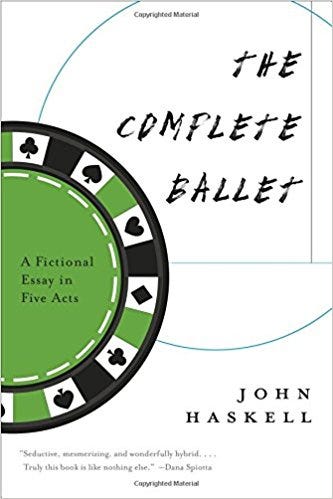
The structure of John Haskell’s new novel, and his first book in eight years, is the most intricate of any of his books so far. In five acts, Haskell fashions a modern tragedy from the stuff of gangster movies, romantic ballet, historical biography, and even puppetry. Each of these subjects inspires and informs the placement of the next. Despite the many interconnected struts and complex buttresses of The Complete Ballet, the essential model for Haskell’s work continues to be a triangle: the grounding line of his skill as a writer, and two intersecting lines (one of story, one of criticism) leaning, depending on each other to finish the shape.
In The Complete Ballet, one of the lines is, unsurprisingly, ballet. Each of the book’s five sections is named for, and contains extensive summary and criticism of, a different romantic ballet (La Sylphide, Giselle, La Bayadère, Swan Lake, and Petrushka). Each ballet intertwines with the novel’s storyline, that of a man who takes a wrong turn into the criminal underworld, and can only, helplessly, fall deeper and deeper into it. Thematic strands of madness, death, eavesdropping, charisma, and desire enrich the book’s tapestry.
Desire doesn’t really care about the object of desire, it cares about itself.
There is more to the unnamed narrator’s story than his being stuck in an unfortunate situation, owing tens of thousands of dollars to men who stalk and threaten him. He had a life before this ballet, and has an apparent life afterward, although the reader gets only limited access to either: a daughter who died young, a marriage that failed, an all-consuming love for and knowledge of ballet that goes unexplained. Despite its title, this book is an incomplete puzzle. But then, the ballets described only show small, dramatic portions of lives, never the full picture. All the audience needs to know about the ballets’ characters, or about the narrator, is revealed through movement.
I’m trying to find for myself a version of life that expresses itself like dancing, like the moving body thinking itself into existence.
The flow of Haskell’s words takes the place of dancing in his “fictional essay.” His writing is spellbinding. Virtually the entire book is told in summary, with few scenes and little dialogue. Although it’s a less common kind of writing in the 21st century than in the 19th, Haskell’s style draws the reader in and forward at a steady, pleasurable pace that renders the book irresistible. The expertise he demonstrates about ballet engenders comfort, a sense of being in good hands, being told exactly what’s necessary. The book shifts regularly from fiction to criticism, from biography to character study, in gentle, expert scene changes visible on the stage.
Lying is also like taking a first step, the first step determining where the next step will go and with each step the weight moves forward, creating the momentum that necessitates another step and then another and I wanted to be transparent. I wanted them to see who they were dealing with, an innocent person. A nice guy.
This passage describes not only lying, but also the entire journey of the book’s narrator. As he falls deeper into the criminal underworld, the narrator’s passivity becomes more and more evident and problematic. “Why not go to the police?” the reader keeps asking. “Why not refuse? Why not leave town? Why not jump off a bridge?” But the journey down, toward murder and ruin, feels too inevitable for other options.
Crucially, this passage about lies also describes the process of writing fiction. One fictional step, and then another, and then continued steps, and then a series of decisions about what to set down next, what the character is going to be like, who she’s going to meet, how she’s going to react to the stranger coming to town or the journey she’ll go on or the love she’ll fall in. Haskell is not a wholly transparent writer, not an innocent person; if he was, he would address the reader more boldly than with textual hints that a consciousness sits behind these lies, well aware that someone out there is listening. But in melding criticism with fiction, he is still doing something only a small share of writers ever do: creating his own genre, his own particular geometric shape.
Haskell’s most famous book, I am not Jackson Pollock: Stories, and his first novel, American Purgatorio, also used the triangle model. The former, a book of hybrid stories, balances between a kind of imagined narrative behind selected films and more businesslike criticism of those films. The latter is a kind of road trip/ghost story invoking Dante. It tugs the reader along beautifully from one sentence to the next, like swimming. Haskell has merged the best qualities of these two books for The Complete Ballet. His critical attention, his intelligence as an audience member, is as discerning as ever, and his skill as a spinner of lies is never in doubt.
A Captivating Verbal Dance: John Haskell’s The Complete Ballet was originally published in Anomaly on Medium, where people are continuing the conversation by highlighting and responding to this story.
